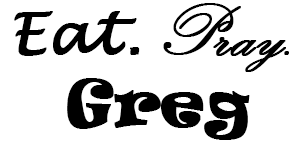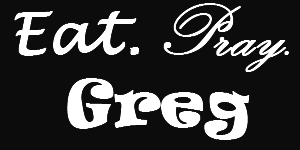I woke up and played a little online. I then headed down to breakfast and talked to another client about maybe doing some more work for him. I tried calling my backup bank to let them know I would be using my debit card abroad. Sometimes when you do not tell a bank you will be traveling, if they see a foreign transaction, they will automatically put a hold on your card which could take 24-72 hours to clear. Unfortunately, they did not answer. I packed up my room and since I had some time to kill, I left my bags at the front desk and then walked back to the Basilica. I ended up having a huge lunch. I retrieved my bag, got an Uber, and started going to the airport in the rain.
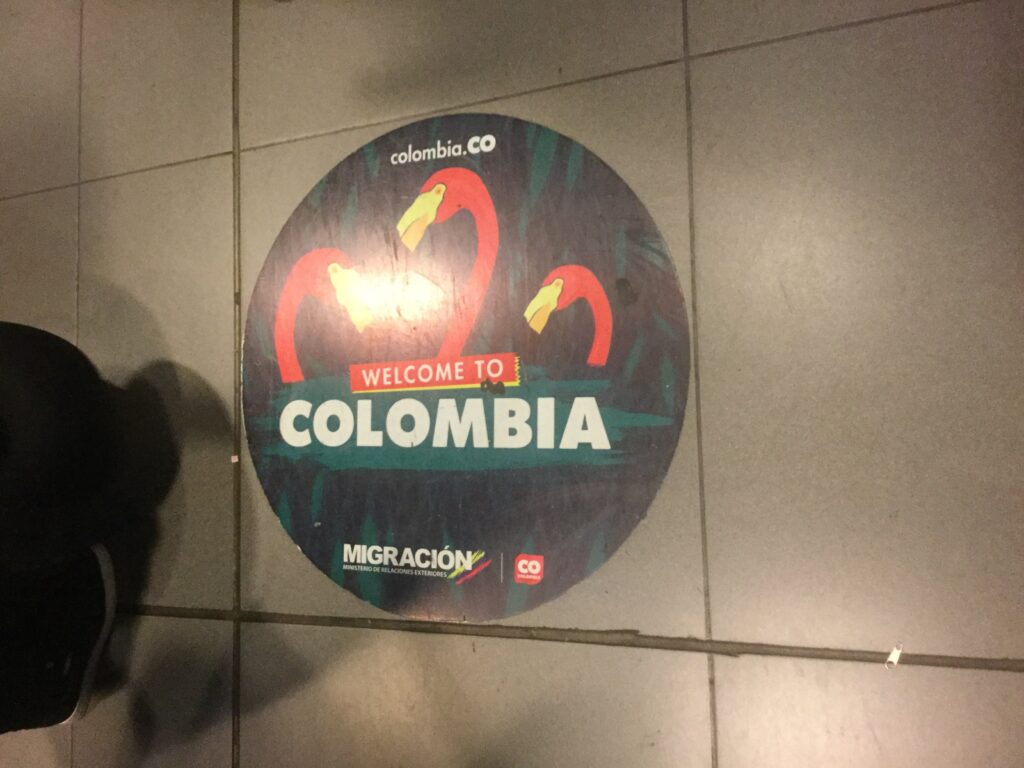
I got to the airport, checked in, and for the first time in my travels was forced to put on a provided mask. Apparently, there was some incredibly viral flu that had come out of China that was quickly spreading around the world. I did not pay it any mind, thinking it would blow over quickly. I boarded my plane, found my seat, and a few hours later, I landed in Bogotá. When I landed, it took me 1:30 hours to clear customs as the line was incredibly long and winding. About 50% of the people were in masks, which made me think maybe this flu thing was a tad more serious.
I was able to get an Uber, but much like in other parts of Latin America, I needed to get it on the sly. In Colombia, the taxi companies had a stranglehold on the market and did their damndest to keep it, making life very difficult for my fellow Uber-istas. My driver told me to meet him in the parking lot adjacent to the terminal. I did, matched the license plate to the car, then hopped in for my 30 min ride to my hostel. I had no idea Bogotá was so huge.
I arrived in a middle-class suburb of the city, got out, thanked my driver, then went inside to get my room. It was a pretty big place and was very modern and bright. So it was surprising when the proprietress told me her credit card machine was broken. I remembered my time in Argentina when this same event occurred. I looked down and saw the same placard saying that stated, by law, they had to accept credit cards. I said that I booked this place specifically because it accepted them. She said she needed cash. I said that I did not have it. She said I needed to get it. I said, OK, I am going to go to another hostel as a bluff and started picking up my bags even though it was in the evening. She looked at her workmate, then got the machine, and low and behold a miracle occurred and it started working again. I paid and was then shown to my bed.
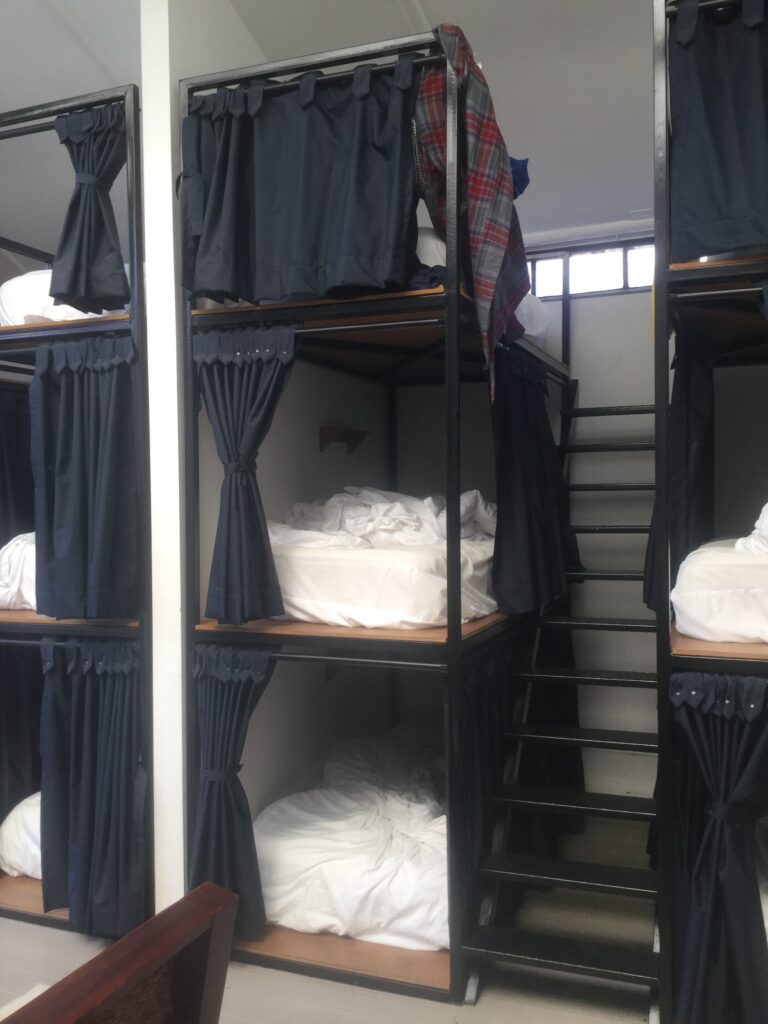
The setup was very interesting. It was a 24 topper, with 8 three-decker bunk beds with stadium stairs to get in and out. I chose the bed that was the very top and furthest away from everyone else which I thought would be the quietest. When I got comfy, I played around on my iPod a little and found out that one of my stocks that had been not only paying my rent before I left but also funding my trip had cut its dividend by another few hundred dollars. I am glad this was happening now and not earlier. Another reason why I was very happy I took my trip when I did.
I got up and took a shower and brushed my teeth. Before I put my toothbrush under the spigot, a spurt of brown water came out, then followed by clear water after that. I did not use water to brush my teeth that night. I then headed up to bed.
The next morning I woke up not really knowing where I was. This was the first time that happened on my voyage and was a very uncomfortable feeling. I got up and went downstairs for breakfast. It was here that I met a lovely young lady by the name of Chloe from England that was studying environmental sciences and conservation at University. She was going to be working at a nature preserve and came to Colombia early so she could get acquainted. She invited me to join her the next day to go on an excursion, and I graciously accepted.
After breakfast, I headed out to meet a walking tour in the center of Bogotá. Looking at the map, I found it interesting that the streets of Bogotá were simply labeled as calles or carreras (streets or routes) with just numbers to tell them apart. I hailed an Uber and was asked to sit in the front seat so as to not make the taxistas suspicious. I liked my driver, not just because he complimented me on my Spanish, but because he was willing to answer some of my tougher questions regarding the city and took me on a little tour of our own.
Throughout the history of Latin America, there have been wars, despots, and disasters. For a lot of reasons, many countries tolerated migrants from other areas of the continent as a kind of refuge knowing that they have been hospitable in the past or will be in the future. This epoch saw a lot of Venezuelans coming to escape dire economic circumstances as well as persecution. My driver took me through a Venezuelan neighborhood and showed me places not to go, the brothels. There were many women standing outside in clothes that left very little to the imagination. I guess the oldest profession was cross-border as well.
Another important fact that my driver shared with me was that at 12:00am in 2 days, Uber would be outlawed in Colombia. Again, this was due to the iron hand of the taxi companies, many of which got their start in the Narco days. I thanked my driver as he dropped me off and I gave him a good tip.
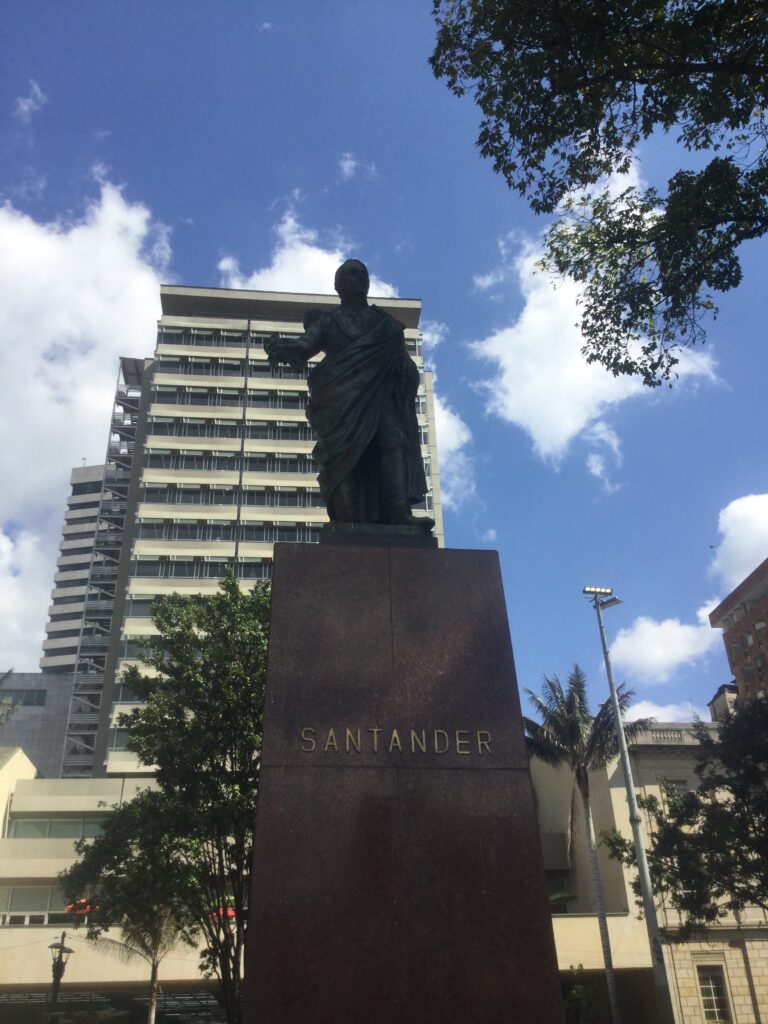
I walked around downtown Bogotá for a little and got my bearings. It seemed like the center of any other city. Before I met my group, I went to an ATM with my backup debit card and was shocked at the fee. It was worse than Cambodia. I then met my guide and group then got acquainted. I learned a lot, but like most of my tours, the facts presented were in rapid succession.
The main things that I took from the tour were these. The first native Muisca people thought that the ample gold deposits in their land, called Bacatá in their Chibcha language, were gifts from God. Bacatá meant fertile land and subsequently got bastardized into Bogotá when the Spanish arrived in 1537.
Flash forward a few hundred years and Colombia was liberated from Spanish rule in 1810 with the help of Simon Bolivar and José de San Martin. This amalgam of land was known as Gran Colombia and was what is currently Colombia, Ecuador, Venezuela, and Panama. This is the reason why they all have similar flags, except for Panama which broke away in 1903 after Teddy Roosevelt decided to build a canal there.
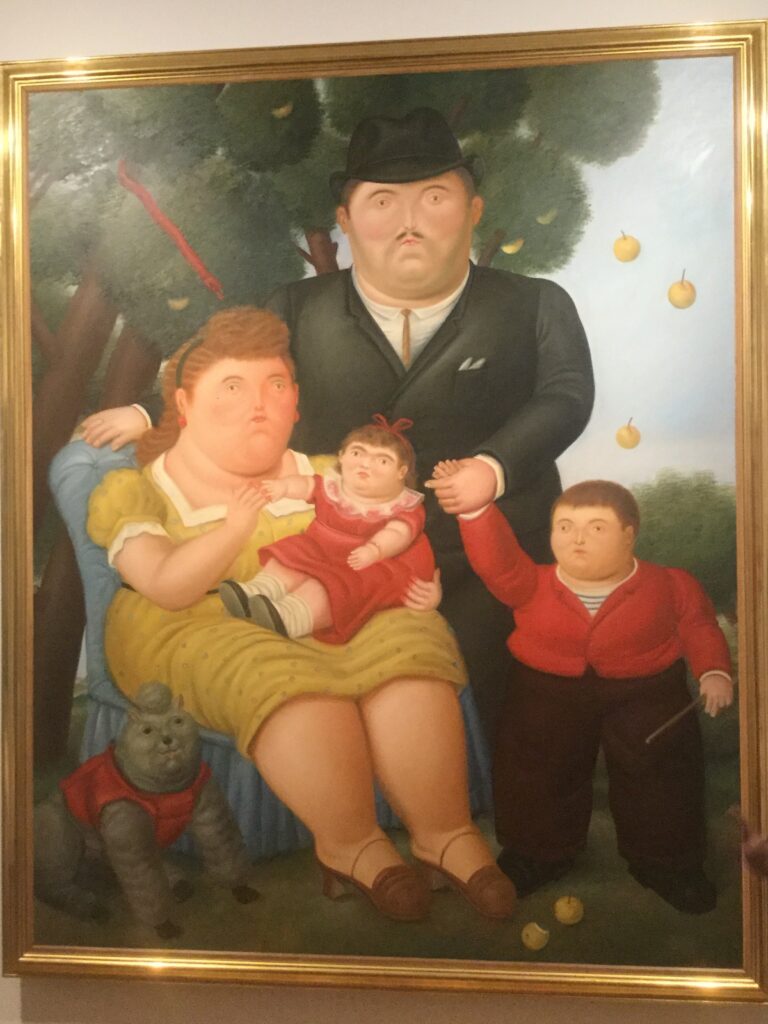
We then made our way to a free art museum featuring one of the most famous artists of Colombia, Botero. Botero’s works simply make things, people and animals, look incredibly fat. This was my first impression. Our guide educated us on the fact that these subjects were not fat, rather, Botero was playing with proportions. The works that we saw had several things in common. The first was the color palette used the same as the colors of the flag of Colombia, the second being that he uses the same face, and that every female nude had a mole on their right butt cheek and was wearing a bracelet. The works featured that contained a snake and an apple also showed some sin being represented.
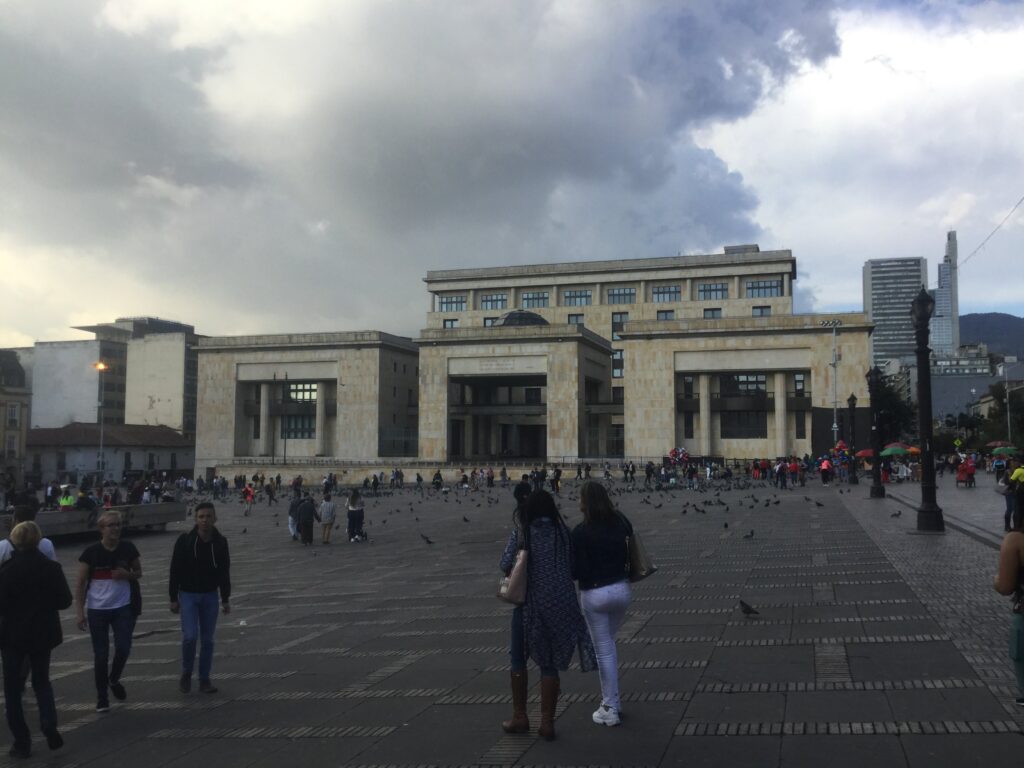
After the museum, we headed over to the city center that housed both the Congress and the Supreme Court. It was a beautiful complex in an otherwise concrete jungle. You could feel the power emanating from these places. Although the Supreme Court building was redone for a pretty obvious reason we will get to.
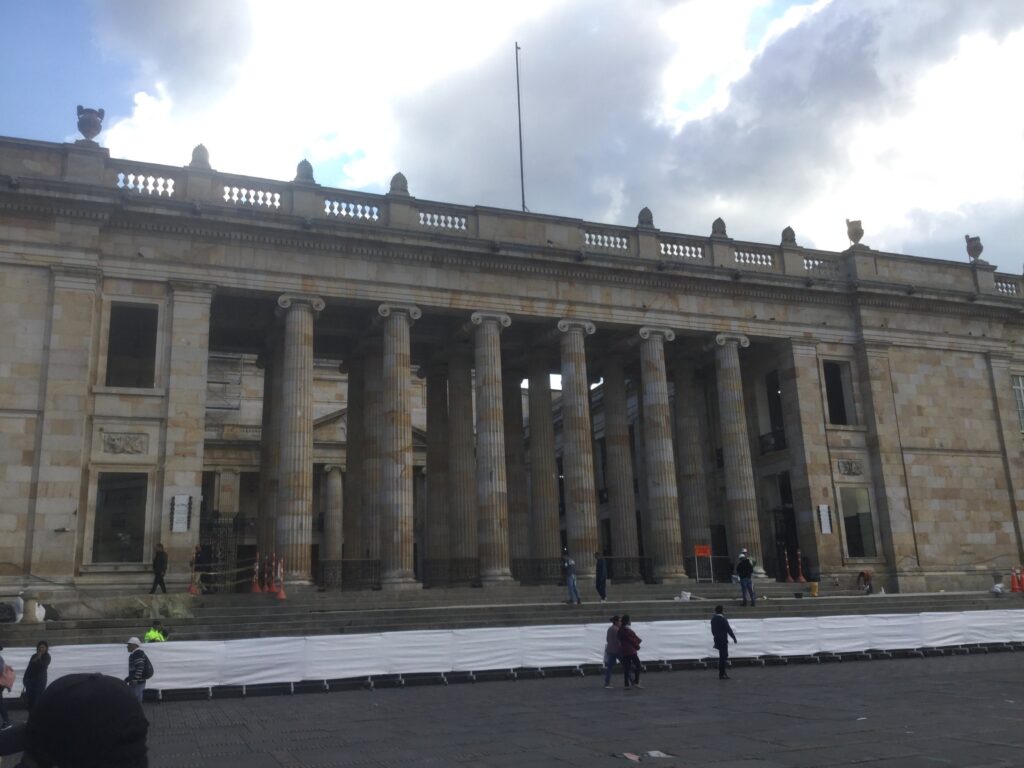
As we were walking our guide shared with us more about the economy of Colombia. Besides its most famous export, Colombia had many other great natural resources. One of the most important is emeralds. I recalled my Spanish professor in college funding his doctoral studies “smuggling” them out of the country in a Pert shampoo bottle. Our guide asked if we noticed the line of jewelry stores on the way to meet him. I had. He said that while these were good quality, best only the best were reserved for appointments and VIPs. He then pulled out a photo of Angelina Jolie with a few brilliant stones hanging from her earrings. Our guide asked if we cared to venture a guess as to how much those cost. He went around the circle and when it was my turn I confidently ventured $2 Million. The guide asked me how I knew and I smiled at my touch of clairvoyance coming out yet again.

We stopped for a bit of a break at a very nice coffee shop with a view of the mountains. While I like coffee sometimes, this stuff was absolutely next-level. It beat Starbucks to hell. And for a fraction of the price!
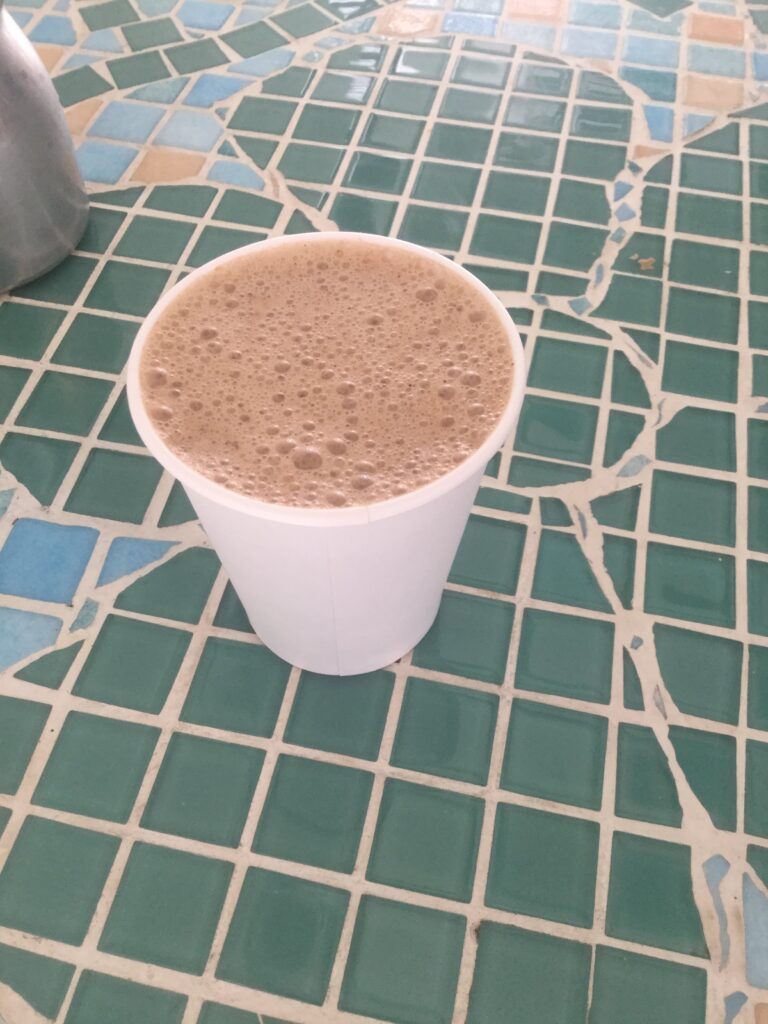
As we were walking back towards the city, our guide shared with us this. In 2010, a young man, boy really, decided to share some of his street art. Unfortunately, he did not have the permission of the owner of the wall, and the owner killed the artist. When another more famous artist that was in town doing a concert ditched his entourage and decided to spray paint a pot leaf on a wall without any penalty, this sent the entire city and country into an uproar of anti-Bieber fever. This then snowballed into a law allowing street art as long as permission was given.
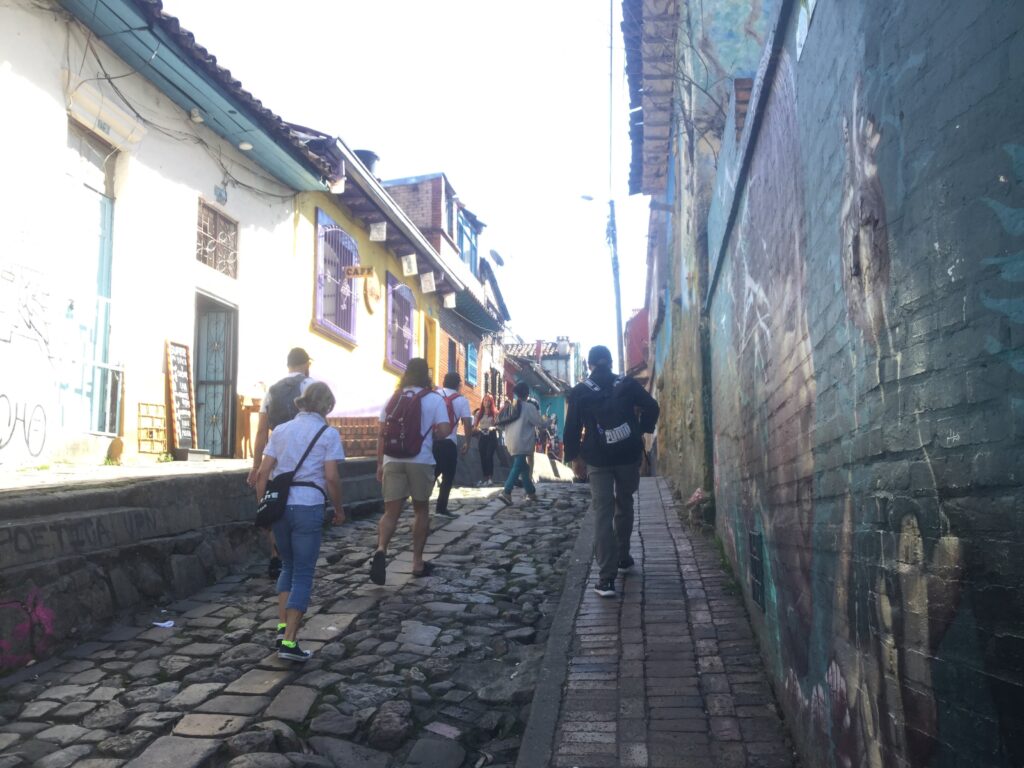
Our tour ended at a rounded building deep within the heart of downtown Bogota. It was kind of nondescript, but our guide said that it represented what it meant to understand Colombia specifically and Latin America in general. This building was the Cultural Center of Gabriel Garcia Marquez. Marquez was the famed Colombian novelist and Noble Prize for Literature recipient, generally cited with creating the genre of Magic Realism; a style mixing elements of the mundane with those of the fantastic. Argued to be his greatest work, One Hundred Years of Solitude is the perfect example of this style. It was here our tour ended with our guide saying that he hoped we were able to look upon Colombia with new eyes.
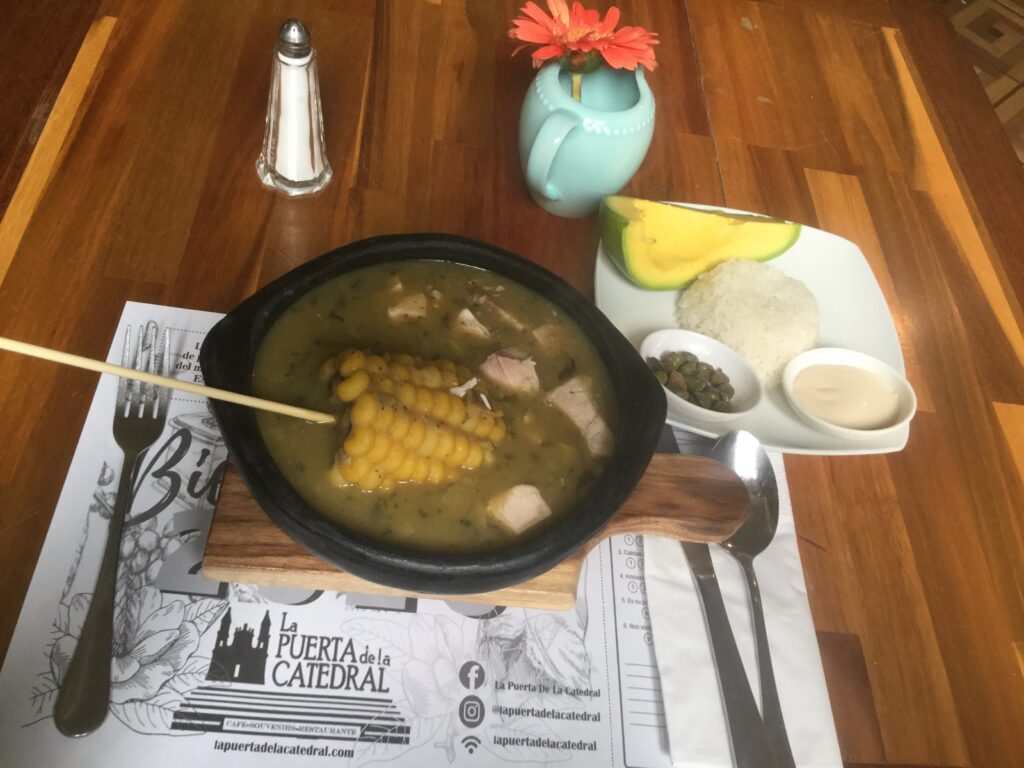
After my tour, I was hungry, so I went to a restaurant that was mentioned on our tour and had myself some Ajico, a traditional Colombian stew. It was great. I noticed a bunch of gringos at another table, middle-aged types that were chatting away in English. Doing my traveler duty, after lunch I stood up, introduced myself, and informed them that if they were using Uber to get around, they will need to find some new way as it would become illegal the day after next. They thanked me very much.
Using the supplied wifi at the restaurant, I got my own Uber and headed back to the hostel. I got some beers from a local bodega, chilled out, then headed to bed.
The next day I got up, had breakfast, and with Chloe in tow, we headed to the War and Peace tour. For a history and poltical junky, I found it fascinating. I learned so much. There were a few things that really stood out to me.
The conflicts in Colombia are sewn into the soil. Stemming from how the government of Spain treated the natives and then their descendants, a majority of the conflicts came from who controlled the land. There are three branches of conflict that come from the mountains, the jungles, and the water.
The politics of modern Colombia were forged through two conflicting personalities: Francisco José de Paula Santander y Omaña and Simon Bolivar. After the war of Independence where both men played an important role, they had several wars. Santander wanted open markets and federal representation, founding the Liberal Party. Bolivar wanted closed markets, and centralized governments, and founded the Conservative Party. And it was here the stage was set for the violent history of 20th Century Colombia.
Initially, suffrage was offered only to men that were 21 years or older and could read. This left a large proportion of the country unable to choose their representatives. Most of the initial violence went back and forth regarding who controlled what land, namely for farming. There was a strike in 1928 on the Cienaga banana plantation that was brutally put down. It was around this time that the nascent Communist Party began taking shape.
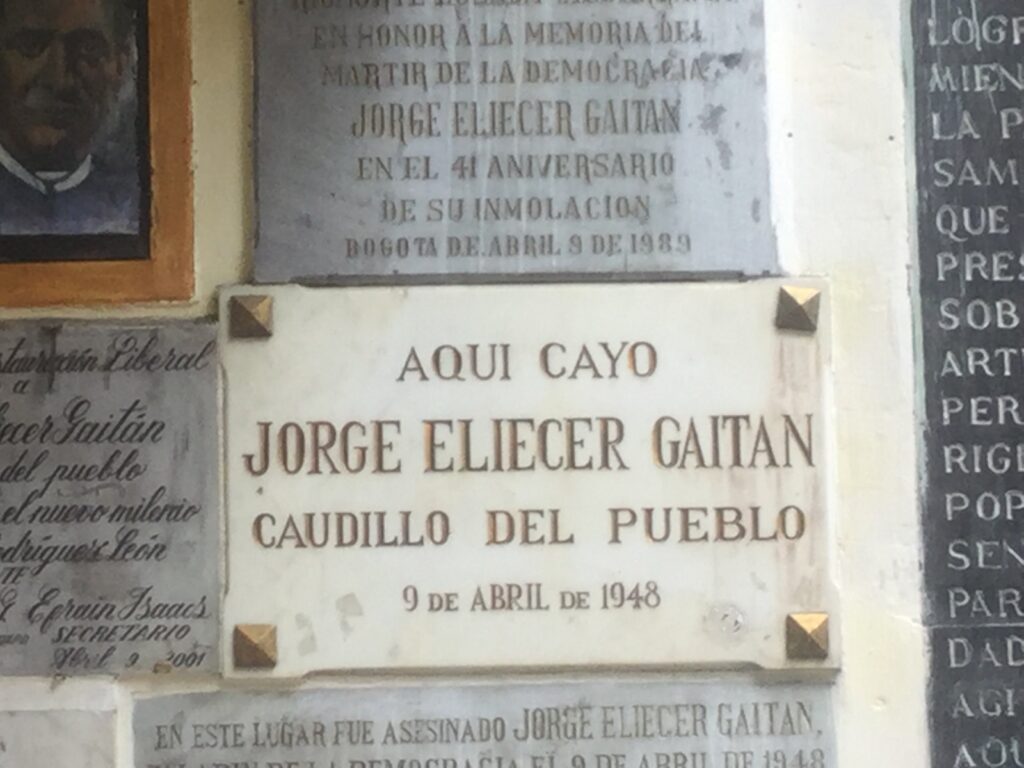
Jorge Eliécer Gaitán Ayala, the Leader of the Liberal Party started encouraging members of plantations to unionize. And for this, he was assassinated in 1948, which subsequently coincided with the timeframe known as La Violencia (The Violence.) Conservative and Liberal party members fought in the countryside and stole land from each other, often leaving desecrated bodies in their wake. This is where the practice of the Colombian necktie was invented, the pulling of the tongue through the deceased’s opened throat, or act the of stuffing the deceased’s severed limbs in their torso after decapitation.
Needless to say, the violence in the countryside, not just in Colombia but in most of Latin America, brought many, many people to the cities. Therefore the population swelled.
With the success of the Cuban Revolution in 1959, the many flavors of communist ideology began taking a larger hold in this part of the world in response to La Violencia. The Fuerzas Armadas Revolucionarias de Colombia (The Revolutionary Armed Forces of Colombia) or FARC was born in 1964 in Marquetalia, in Southern Colombia.
However, while they were the most famous, known for their “fundraising” activities, there were other groups. The Ejecito de Liberacion Nacional (Army of National Liberation) or ELN was founded around the same time as FARC. This group was founded by university students that studied abroad in Cuba, learning the ways of Revolution. Another group was M-19 or Moviemiento 19 de Abril. M-19’s claim to fame, besides targeted assassinations, was the siege of the Palace of Justice in 1985, resulting in its complete destruction by fire. Along with the deaths of 11 of the 21 Supreme Court Justices.
The communists did not hold a monopoly on violence in Colombia. Another group called Autodefensas Unidas de Colombia (Self-Defense United of Colombia) or AUC, was the right-side equivalent and often skirmished with the other groups.
By the 1970s there was yet another group adding to the almost constant body count of Colombians. These were the Narcos or drug cartels of the country. These nimble businessmen played on all three teams working with the communists, the right wing, and in some cases, the government.
Still, there were also paramilitary forces that were kind of affiliated with one group or another, but it was more splintered and for local protection, like the UVF in Belfast. And it was these people that did a majority of the killing from 1995 to 2002, using mostly machetes and chainsaws, reaching its crescendo during the El Salado massacre of 2002.
It was here that I learned of the term False Positives. There was a bounty program on suspected members of the “other” side where people were paid in either cash or time off. This however had the unintended consequences of soldiers murdering civilians, then dressing them up to look like the enemy. It was a very, very nasty time in Colombian history.
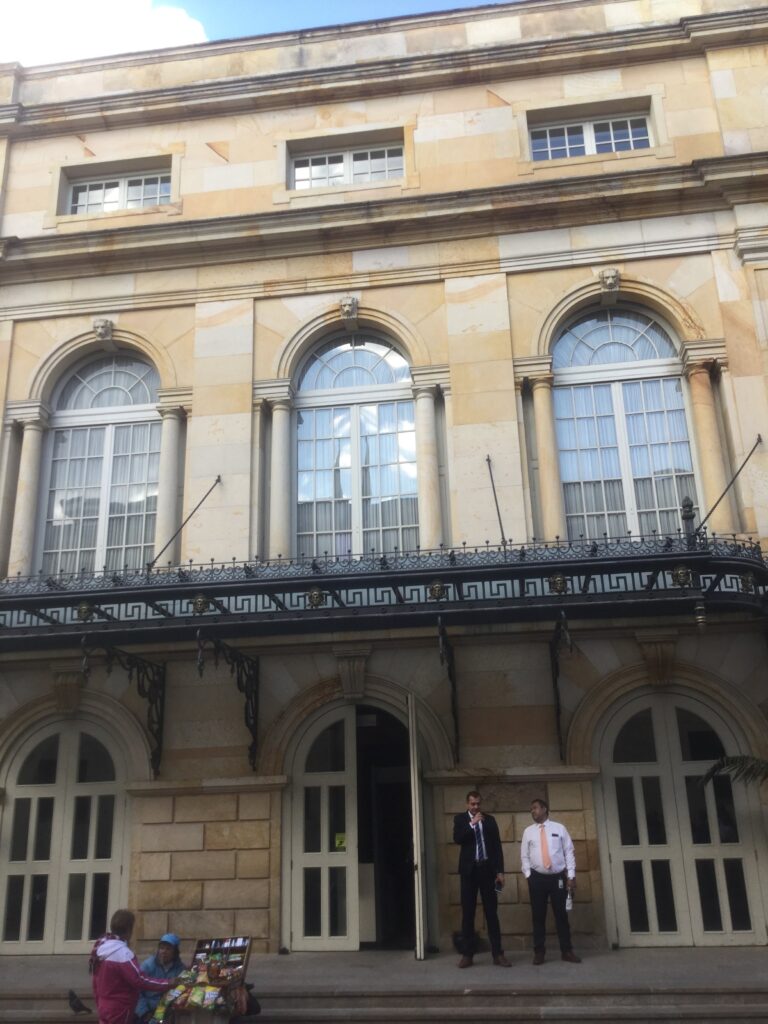
However, the chapter finally came to a close in 2016 with the signing of Peace Accords at the Colon Opera House between FARC, the AUC, and the government. The people initially voted it down as they felt it was too lenient on the people that terrorized the country for five decades. After negotiation, they reached an agreement that allowed reparations to the people that had been affected by their violence as well as allowing the groups a political opportunity to create a party.
But the moans of the dead can still be heard. Chiquita Bananas was accused of giving weapons and support to paramilitaries during the conflict to protect its interests. And in a 2018 study, it was shown that the top 1% of the population of Colombia owned 89% of the land. The rich getting richer and the poor getting poorer.
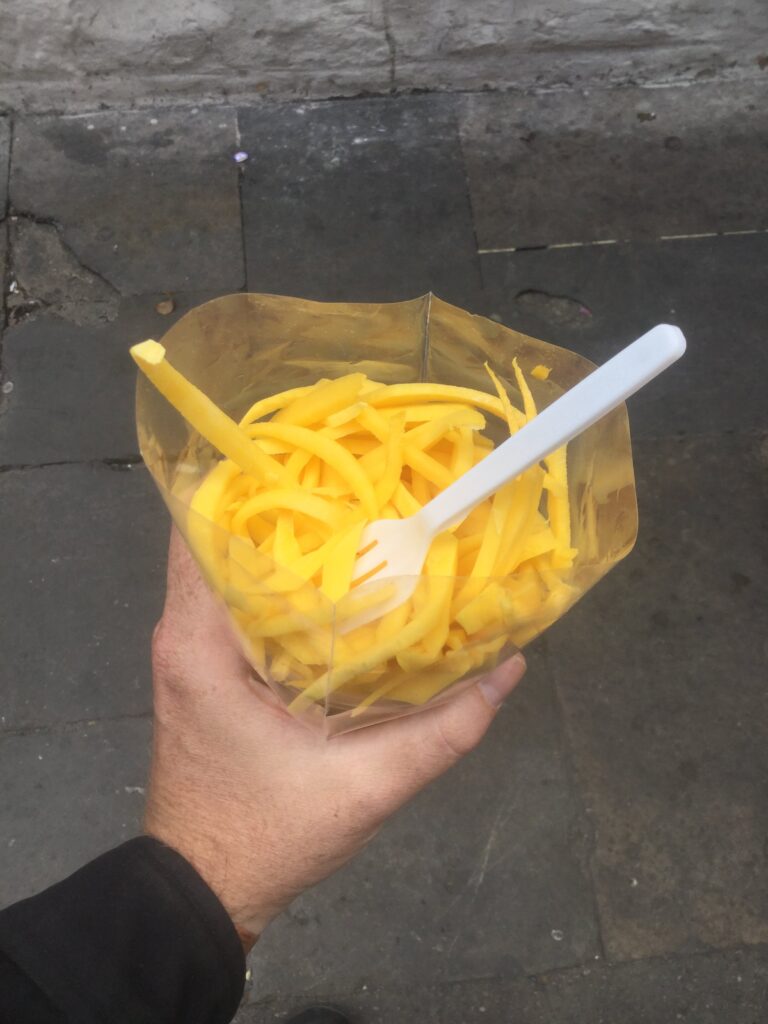
Already having been a packed day, Chloe and I caught an Uber and headed to a local bus station. But not before we shared some sliced mango. Thank God I went with her because she did not speak a lick of Spanish. It was a little confusing, but we found our bus and hopped on. It was a collectivo, meaning that it was a cheap ticket but absolutely packed. There was also the peculiar habit of people jumping on the bus to sell snacks and drinks and then jumping off. It took us about an hour to get there and Chloe gave me her life story. As we were obviously gringos, a very nice man asked if we were going to the cathedral. I said yes. He then told us where to get off the bus.
We got off, then found a taxi willing to drive us up to the entrance. It took Chloe a little time to re-get her ticket as she sent it to the wrong email, then we started our descent into the cathedral of salt.
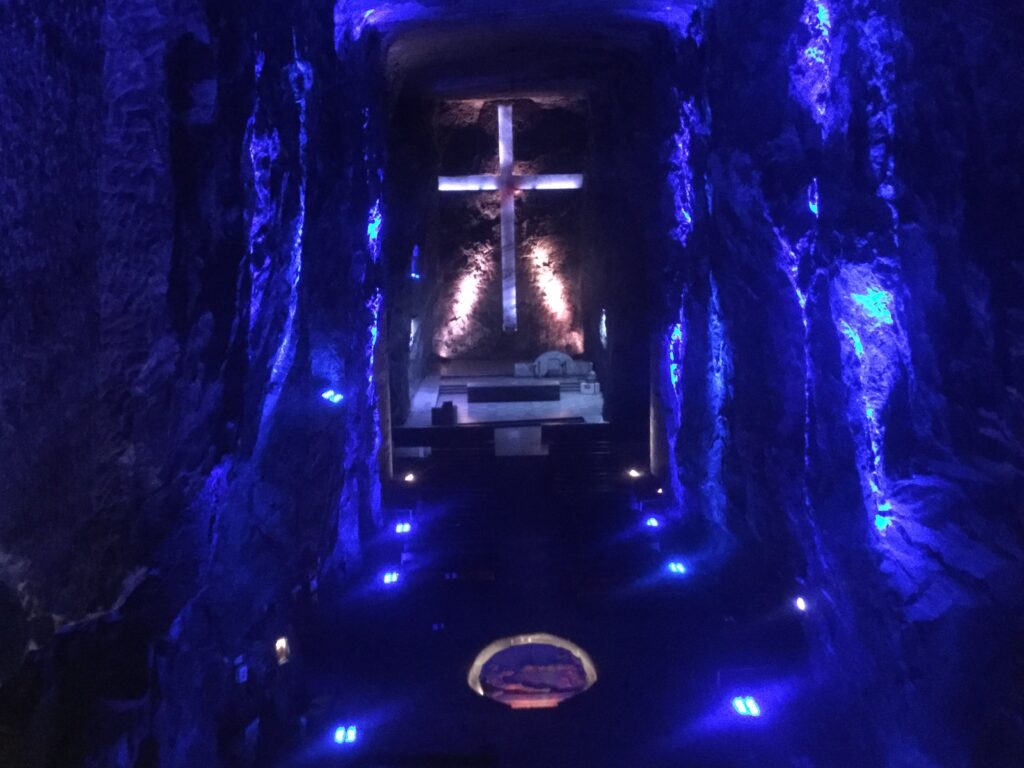
![]()
The Salt Cathedral of Zipaquirá was first used by the natives of Colombia in the 5th Century BC as a mining operation of rock salt, an often underestimated engine of human activity (thank you, Mark Kurlansky.) Since, the mine was a place to collect salt and became very important in trade for the area. Since mining could be dangerous work, starting in the 1930’s, workers began carving crosses as places to pray during breaks. In 1950, work began on the first Cathedral, being completed in 1954. A new cathedral was built under the old one starting in 1991 and ending in 1995. The Cathedral has been called a “Jewel of modern architecture.”
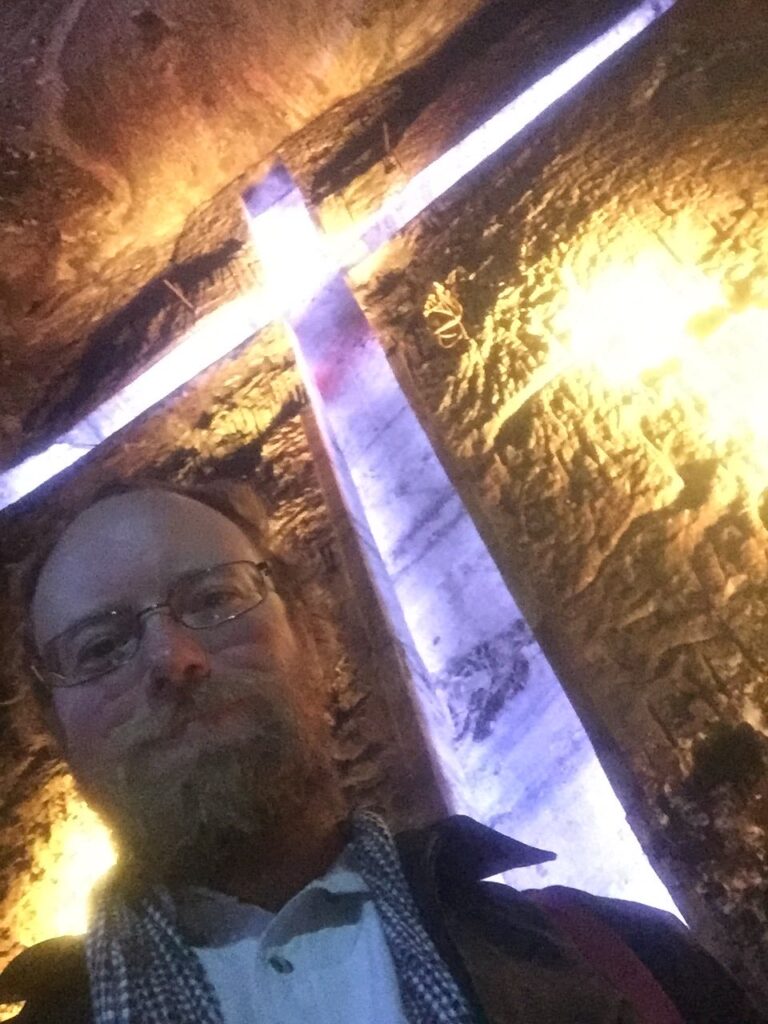
To say that this was one of the coolest places I had ever been is an understatement. We opted for a guide instead of an audio tour and he told us all about the place. It was dark and cool, but not musty at all. We saw stations of the Cross all carved in salt. Then continued our descent to the bottom floor 600ft below ground. The whole place had lighting like a rave, lots of colored neon lights that perfectly highlighted the space. And it only cost $3 Million to make! Our guide looked at Chole and I, mentioning that it only cost $35,000 to rent the space for a wedding. I don’t think she picked up on the connotation.
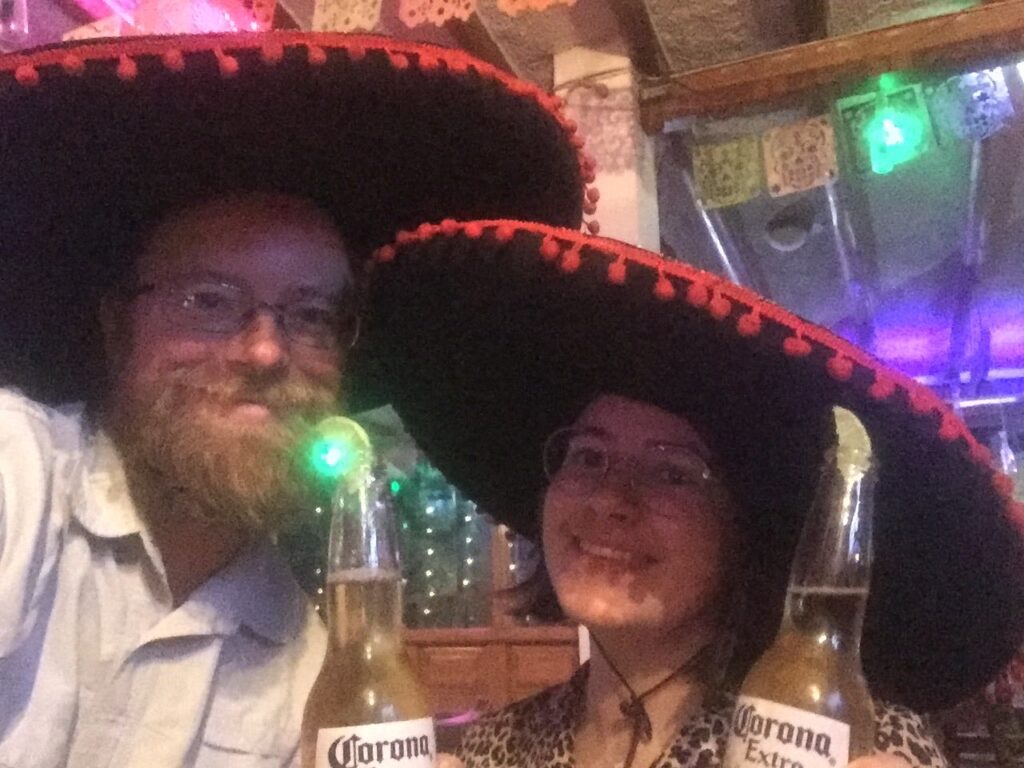
Afterward, we headed back down to the town, stopping to get some salt souvenirs. Since we were hungry, and Chloe came from the Island of Bland Food, we found a little Mexican restaurant. We donned our provided sombreros and took our seats. In a hubristic taunting of the Gods or whistling past a coming graveyard, we ordered some Coronas given the news of this strange virus that was spreading around the world continuausly unabated.
After dinner, I asked the wifi code of the restaurant. They asked why. I said that I wanted to grab an Uber back to Bogota. The three men at the bar jumped and said that they would take us and it would be so much cheaper. I said no thank you and they got very pushy. I was not taking any chances. I thanked them, had Chloe leave first as I backed out the door and hooked into the municipal wifi, and got an Uber to meet us at a local square.
When we got in, Chloe was very relieved that I did not give in. She said she got a very bad feeling about those guys. I said that being paranoid has kept me out of a lot of trouble. Our driver was very quiet and nice and got us back to Bogota for $12 for an hour’s ride. Oh, the wonders of Geoarbitrage. We got back to the hostel, got cleaned up, said our goodnights and I went up to my bunk and immediately passed out.
I would be off to Medellin in the morning.
